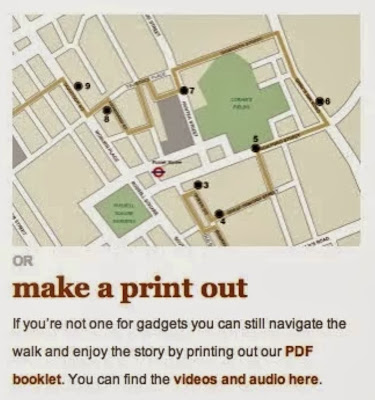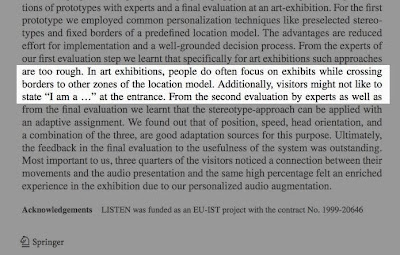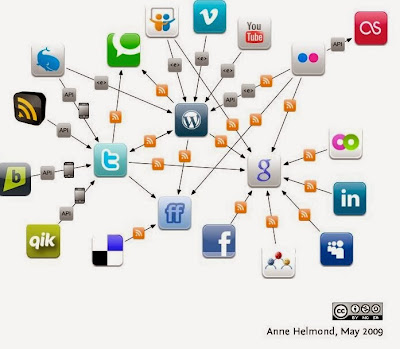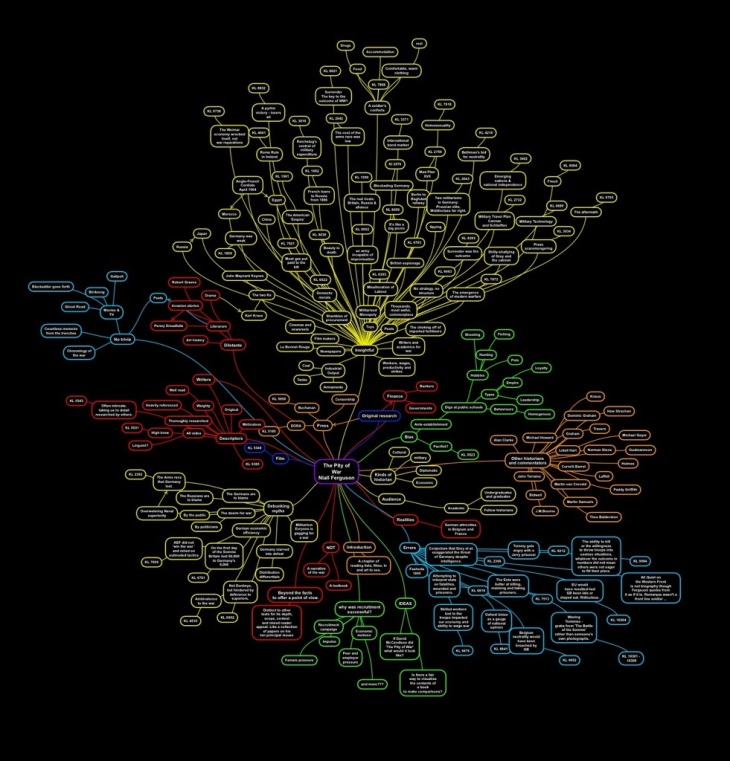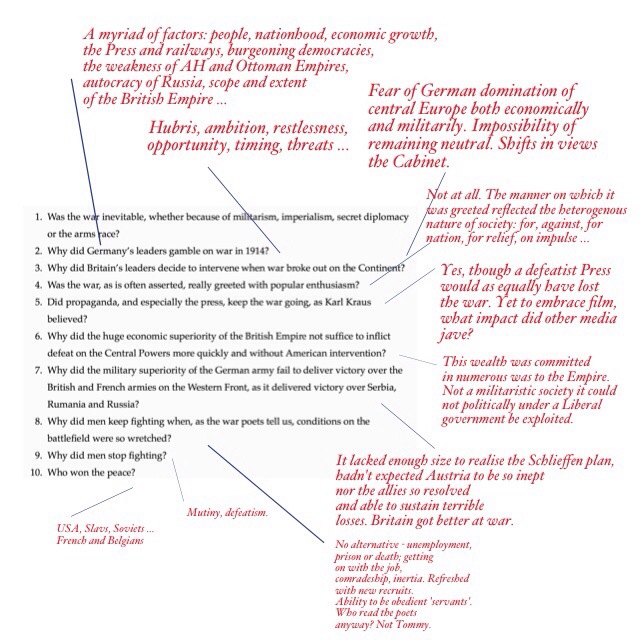Home » Posts tagged 'mindmap'
Tag Archives: mindmap
How I assembled a presentation as an exercise for the Open University Master of Arts in Open and Distance Education module H818: The Networked Practitioner
From the start of the Open University postgraduate master’s module H818: The Networked Practitioner I’ve aggregated screen grabs and photos into a dedicated album in Google+ ‘Picasa Web Gallery’. This, as a resource and aid memoir, also received copies of images from other albums, including the another two albums on elearning that contain some 3000 images from the six MAODE modules that I have done over the last four years and from other albums on the First World War and specific museum visits, including: the Museum of London, the Great North Museum, the Design Museum, the ‘In Flanders Fields’ and ‘Talbot House’ in Belgium, as well as inspiration and insights from the Picaso and Miro Museums in Barcelona and Alcatraz in the Bay of St.Francisco.
 |
| From E-Learning III |
My interest in museums is lifelong and something emanating from them or to support them had been an intended topic for my last MAODE module H809. My interest in the First World War is also lifelong, fed by my late grandfather, a veteran of that conflict who lived into his 97th year – long enough to attend various events to mark the 75th anniversaries of the Battle of Passchendaele where he served as a machine gun corporal and the formation of the Royal Air Force as he had transferred to the Royal Flying Corps at the very end of 1917. Given the approaching centenary of the 1914-18 War I took the decision to enhance and formalise my understanding of the conflict with an MA in British First World War studies at the University of Birmingham. I further justify this by valuing the insight of doing a ‘traditional’ though part-time MA that requires attendance at lectures, and a substantial amount of reading – even from books, some of these a century old and getting a taste for another institution’s online offering. Here are my mashed up notes from a lecture on reviewing a text.
First ideas were around the use of QStream, a platform with its origins in supporting junior doctors in North America to pass tough written tests of their knowledge. Simply shoehorning in an idea rather than seeing what needs exist, or problems there are, say with museum or battlefield visits isn’t to be recommended. It was necessary therefore to try out for myself some of the mobile guides, for example City Walks.
I knew from experience the year before that QR codes had been used in the Digital Crystal exhibition at the Design Museum – efforts failed here as the promised free wi-fi didn’t work. A visit to the Museum of London was more satisfactory though throughout my visit I never saw anyone use them – spoilt for a wealth of activities and options, including touch screen interactive and computer consoles alongside many tactile and engaging ways to enjoy the exhibits perhaps rendered them redundant.
Most treasured visits to museums include the Royal Academy of Arts where my mother took my daughter, then 12/13 under her wing. I was also impressed by the quality of the audio guide at Alcatraz that featured the voices of inmates and prison officers.
—-
Reading I do always includes some kind of note taking; how I achieve this using digital tools varies. A significant, if not most of my learning is done via an iPad. Experimentation and habit has me use Kindle tools to highlight, tab and add notes that I later review and grab, while with papers I typically do a number of things: cut and paste a Harvard reference into my OU Student Blog which I use as an ePortfolio, as well as saving into RefWorks, while downloading the paper to a dedicated module folder. Rather than take notes, which I may do in front of a computer or very rarely these days onto paper, I will, as here, highlight and grab then later annotate and potentially post with notes and tags into a blog.
——
My established habit is to deconstruct a task into its component parts – in this case an early step towards a ‘multi-media artefact’ using SimpleMinds, a favourite App that I have on the iPad and Mac-Mini.
This detailed mindmap was an early step in assembling a ten minute presentation I gave on OULive on Monday on the potential and pitfalls of using Quick Response codes in education. Its next iteration was as a Prezi. It was ultimately delivered as a PowerPoint consisting of eight or nine slides.
Here I took some of my grandfather’s photographs and mashed them up using the apps ‘Studio’ – a graphics/sharing app and ‘Brushes’ – the iPad ‘painting’ app favoured by David Hockney. Together these allowed me to assemble layers of photographs, text and graphics so that I could express an idea visually.
At some stage I had the idea of putting a Quick Response in a Royal British Legion Poppy – as much for the promotional grab of the image as the practicalities of doing so.
In a module titled ‘The Networked Practitioner’ that is part of the Open University’s ‘Masters of Arts in Open and Distance Education’ the prompt to use, indeed the necessity to at least try a variety of sharing platforms is inevitable. Within the ‘walled garden’ there were module, student and tutor forums, OpenStudio, and wikis, while managed exposure beyond these walls included use of Cloudworks and the Open University student blogging platform. My own extensive use of external platforms includes blogging since 1999, and has developed to include: Linkedin, Facebook, Google+, Twitter, WordPress, Flickr, YouTube, Stumbleupon, Pinterest and others. Flickr and blogging has brought me to the attention of the BBC and National Trust, as well as individuals able to support my specific interest here on the First World War: a blogger in Belgium, the grandson of a veteran, a local historian in Hastings, a post doctoral researcher at King’s College, London, an author writing on the First World War for the National Trust, the Western Front Association who have published my grandfather’s story and a researcher and subsequently the BBC to feature in a story in their ‘People and Places’ series.
——
Picking a Creative Commons copyright attribution only came after slides had been submitted to the presentation coordinator. Even once having reduced the number of slides proposed and having greatly simplified the images to be shown the need would then ideally to have added the CC as yet another layer onto these images – all the more reason to leave this task to the end once I had reduced some 32 images down to 8. Further simplification would be to restrict my use of images to my own photographs, charts and drawings. An attribution I may have circumvented is to acknowledge or link to Apps such as ‘Studio’ and ‘Brushes’ while I find it all too easy to lose track of where an image was sourced given how many screen grabs I do and photographs I take every day.
——-
Future plans would be to expand the thinking expressed in the OULive presentation to include a platform such as QStream that feeds by email spaced repetitions on a subject. I imagine a teacher, rather than the secondary school student, assembling a ‘cheat sheet’ of key facts as a revision sheet that is then offered back to them on their phone until, literally, they ‘have it in their heads’. This I base not only on the idea that managing our inclination to forget is a necessary part of formal learning but that only once you have aggregated enough ‘stuff’ on a topic in the brain can it be expected to make its contribution by enabling you to answer exam questions, but also by offering and allowing you to formulate your own ideas.
The Pity of War: Mindmap for a Book Review
Fig.1 SimpleMind Mindmap based on Niall Ferguson’s ‘The Pity of War’
I’ve now read ‘The Pity of War’ twice in a row. As I’ve gone through it I’ve highlighted passages and added notes
and tabs in Kindle. I also grabbed a few highlighted passages and put them into the iPad App ‘Studio’ to annotate and took slides from a
presentation on how to prepare a book review by Dr Pete Gray of the University of Birmingham and annotated these too.
On the second reading I created the SimpleMinds mindmap above.
This ought to be my starting point for a solid 1,000 word book review.
Further reading in the from of Books and papers of interest have been picked up along the way too.
Those to find in a university library, those acquired secondhand through Amazon or uploaded as eBooks in Kindle and papers I can find as a postgraduate student online, either through the Open University or the University of Birmingham (I am a postgraduate student at both). There are various ways I can offer the above, though the best is to download the FREE version of SimpleMinds and read it that way.
Offered with a view to sharing the views of others.
I can export it into a word file and develop the categories I already have as separate themes:
Insightful (in yellow) has some 52 notes, most referenced by Kindle Link (KL).
Do I buy the print version or go to the library and cross-reference?
Descriptors: meticulous, original, weighty, highly referenced, all sides, high brow, thoroughly researched, well read … often
intricate, taking us to detail researched by others? NOT, as he says in the introduction, a textbook or a narrative of the war.
No Trivia – nor the chronology if the war, nor countless aggregated memories of veterans, though there is a bit of poetry and some
mention of movies and TV films from ‘All Quiet on the Western Front’ to ‘Birdsong’, ‘Gallipoli’, ‘Blackadder goes forth’ and
‘Ghost Road’ Bias – I wonder about this in relation to where Niall Ferguson – that he relishes a dig on the landed gentry and public
school system, their types, behaviours and hobbies, from leadership to country sports.
Debunking myths: the desire for war, the Germans to blame, the Russians to blame, militarism, German economic efficiency, not donkeys, the AEF didn’t win the war and blundered in making the mistakes of 1914, naval supremacy and ambivalence to war.
The Press – censorship, Buchanan, DORA. Finance – givernments
and bankers.
A dilletante, too thorough, comprehensive: penny dreadfuls, invasion stories, art history and drama, from Karl Kraus to Oh What a Lovely War.
Errors or mistaken emphasis: Fashoda, conjecture that Grey et al. exaggerated the threat of Germany despite intelligence, attempting to interpret stats on fatalities, wounded and prisoners, the Entente were better at killing, maiming and taking prisoners, Tommy gets angry with a Jerry prisoner, All
Quiet on the Western Front is not biography though Ferguson quotes from it as if it is. Remarque wasn’t a front line soldier. The Oxford Union as any kind of representative body for comment. That Belgium neutrality would have been breached by GB. That skilled workers lost to the war impacted our economy when women very effectively stepped in. That the EU in its current form might have emerged has GB stayed out of it. That waving Tommies are from a photo archive when they are grabs from the Battle of Somme footage.
Kinds of historian: cultural, military, diplomatic, economic.
Why was recruitment successful? Recruitment campaign, female pressure, peer and employer pressure, impulse, economic motives, and more?
Other historians and commentators:
Alan Clarke, Lidell Hart, John Terraine, Correlli Barret, Michael Howard, Norman Stone, Lafell, Bidwell, Graham, Travers, Holmes, Martin van Creveld, Dominic Graham, JMBourne, Michael Geyer, Martin Samuels, Gudmannskn, Paddy Griffith, Theo Balderston, Knaus and Hew Strachan.
With distinct sections on:
Finance and JMKeynes Writers
With a bit on poets, and rather less on films and art.
What did he leave out then?
- Women
- The Home Front
- Technological developments, especially in the air
Fig.2. A brief response to the ten questions Ferguson poses at the start of the book and attempts to answer by the end – I’m not wholly convinced.
Time to write
Fig.1 H809 EMA Mindmap (for fellow H809 / MA ODErs I’ve added a PDF version in the TMA Forum) Created using Simpleminds.
- H809 – Practice-based research in e-learning
- MA ODE – Masters in Open and Distance Education
- TMA – Tutor Marked Assignment
- PDF – PDF
Yonks ago I realised for me the best time to study was v.early in the morning. 4.00 am to breakfast isn’t unusual, 5.00 am is more typical. All it costs is an early night. This is easy too – no television. Its move from the shed to the dump is imminent.
A week ahead of schedule I find I have an EMA to complete – this’ll give me a three hour, exam like run of it. Even the dog knows not to bother me.
For those on the same path the mindmap of my H809 EMA is above.
Ask if you’re interested in a legible PDF version.
This gorse bush off density has patterns within it that I can decipher. The net result ought to come out somewhere around the 4,000 word mark too. This approach could not be more different to my earliest TMAs and EMAs three years ago – they were too often the product of what I call ‘jazz writing’ (this kind of thing), just tapping away to see where it takes you. This process used to start on scrolls of backing wallpaper taped to my bedroom wall. Now it goes onto a whiteboard first.
As always this blog is an e-portfolio: most notes, moments in student forums and references are in here.
I recommend using a blog platform in this way. You can default to ‘private’, or share with the OU community … or ‘anyone in the world’. One simple addition to this would be a ‘share with your module cohort’.
By now I have clicked through some 165 posts taggeed H809 and can refer to H809ema for those picked out for it.
One split occured – I very much wanted to explore the use of augmented reality in museum visits, but found instead a combination of necessity and logic taking me back to the H809 TMA 01 and a substantial reversioning of it. Quite coincidentally this proposed research on adherence to preventer drugs amongst moderate to severe asthmatics had me taking a very close interest on a rare visit to a hospital outpatient’s. Nasal endoscopy must look like a circus trick to the casual observer as the consultant carefully ‘lances’ my skull through the nose with a slender and flexible rod on which there is a tiny camera and light. ‘Yes, I can see the damage from surgery’ he declares (this was 33 years ago), ‘but no signs of cancer’.
There’s a relief.
An unexplained nose bleed lasting the best part of 10 weeks was put down to my good-boy adherence to a steroid nasal spray that had damaged the soft tissue. And the medical profession wonder why drug adherence can be so low? 20% to 60% 33 years on and courtesy of the OU Library I found a wholly convincing diagnosis – allergic rhinitis. The ‘paper’ runs to over 80 pages excluding references and has some 20 contributors (Bousquet, 2008). I’ll so miss access to the online library as most papers appear to cost around the £9 to download. This desire to remain attached by a digital umbilical chord to such a resource is one reason I wish to pursue yet more postgraduate studying and potentially even an academic career. I get extraordinary satisfaction browsing ‘stuff’ to feed my curiosity.
When I stop diddling around here I’ll pick off this mindmap in a strick clockwise direction from around 1 O’Clock.
Simpleminds is great as a free App. It’s taken me a couple of years to get round to paying £6 for a version that can be exported into a word file though I rather enjoy the slower, more considered ‘cut and paste’ which adds another opportunity to reflect, expand or ditch an idea.
REFERENCE
Bousquet, J, Khaltaev, N, Cruz, A, Denburg, J, Fokkens, W, Togias, A, Zuberbier, T, Baena-Cagnani, C, Canonica, G, Van Weel, C, Agache, I, Aït-Khaled, N, Bachert, C, Blaiss, M, Bonini, S, Boulet, L, Bousquet, P, Camargos, P, Carlsen, K, & Chen, Y (2008) ‘Allergic Rhinitis and its Impact on Asthma (ARIA) 2008 Update (in collaboration with the World Health Organization, GA2LEN’, Allergy, 63, pp. 8-160, Academic Search Complete, EBSCOhost, viewed 19 June 2013.
Here’s a mindmap on ‘Digital Scholarship’
Fig. 1. Mindmap on Digital Scholarship
- Drawing on ideas from ‘The Digital Scholar’ Martin Weller,
- ‘Blended E-learning’ Chris Pegler
- and my own OU and e-learning blogs.
The use of video in e-learning (part two)
‘How’ and ‘Where’ you show your video content has become part of the brief.
It makes a difference in terms of the audiences and potential audiences that can be reached and the way in the which your content could, if you wish, be reversionsed and used in different ways (hopefully, under the right Creative Commons) with links back to you.
On your website, whether on the intranet or for external viewing where it can be shared and discussed.
It can also go out as a channel in its own right. At the broadcast end I recently saw what some of the content going out on Channel Flip. Today you can have your own channel. If you have appeal to an audience and can attract enough viewers advertisers will sponsor your content.
E-learning has become far easier to mange and distribute with platforms such as present.me for video, but also specialist mobile e-learning platforms like GoMo from e-learning specialists Epic.
The right content may be used in qualifications too.
Put on YouTube your content can be embedded within other people’s content while you can take advantage of detailed analytics, not least viewing behaviours.
Creativity – Can it be defined or contained?
Though cryptic this means something to me and will jog the memories of my 12 or so fellow OU students on ‘Creativity, Innovation and Change’.
The reference to ‘Chizsentmehighly’ refers to Mihaly Csikzentmihalyi and Chapter 1 of the Course Resource Book ‘ A Systems Perspective on Creativity’. Henry refers to the course Chair, Professor Jane Henry who also features in the 28 minute audio programme that I have now listened to FOUR times. (In surveys I come out extremely low on my ability with or liking of ‘auditory’ learning; give me a visual and some words, please).
In a subgroup and then in the form we discussed the meaning of ‘creativity’ (ostensibly in the buisness context). We found we needed to qualify it, to set parameters and have goals or outcomes. Are you, for example, creative if your ideas are in your head? Or if they are ‘random acts of weirdness?’
We were made to think about use of models too, there are a couple in the Block 1 reading. The important thing I have learnt is to recognise that a model is one person’s simplification of the complex. You may never get onto their wavelength, and if you do, recognise its failings. Figure 1.1 in the Csikszentmihalyi chapter is an example. Csikszentmihalyi (1999) Having studied Engestrom I prefer his Activity Systems. Tersa Amabaile in ‘How to Kill Creativity’ has a more easily understood Venn Diagram with ‘Creativity’ at the centre of Expertise, Creative Thinking Skills and Motivation. (Amabile, 1998)
Context is important. Although I’ve put Apollo 13 here, we actually discussed some other example of ingenuity in a moment of crisis. This on the basis that creativity is often forthcoming at times of crisis (indeed one of the ‘business guru’s Jane Henry interviews charts innovation and creativity and puts in the need for pressure as delivery of a project is reached). The other examples remind me of the eclectic mix of backgrounds of my fellow students from whom some rich examples were given: the Army, Air Traffic Control, Manufacturing electronic lighting systems in Finland, TV, the NHS, Marketing, a County Council and so on.
Gwok Kann, Jackson Pollock, Greyson Perry and Travey Emin got a mention, as did Steve Jobs, James Dyson and Bill Gates. We got into pigeomn-holing people as ‘innovative’ or ‘adaptive’ and were warned of a ‘two box thinking’ (that we can quickly confine oursevels to a limiting debate).
Something similar was achieved by a Game where in groups we were given a set of nine cards: 7 with letters on them, one with a symbol and one blank. We were told to come up with a three letter anagram that would be readily understood by others. We did QE2, KPI and then by tearing the ‘Pi’ symbol in half and making it into an ‘I’ ‘CIA’. In this instance we got into a conversation about how we set ourselves parameters, that we automatically follow rules and make assumptions even when there is no need to do so. We could have turned the cards over and written any letters we liked. The game had not come with a rule book.
Clearly I’ll be adding to this, letting the tutorial act as a catalyst on the books, CDs and other online resources, as well as discussions in our tutor group.
